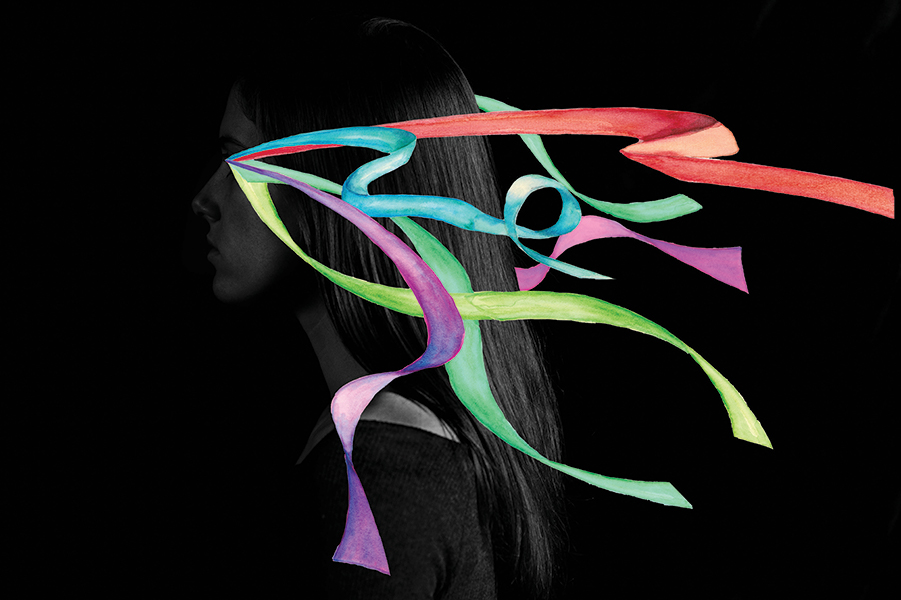Into a World of Color
Exploring the secondary sensation experienced by synesthetes and how it impacts their lives

Art by David Foster
Our unique perception of every individual we encounter is a natural aspect of the human thought process. When meeting someone new, we may register their eye color, posture or tone of voice, often times developing judgements based on those observations. However, for Palo Alto resident Marena Herr, a freshman at Menlo School, the cognitive stimulation she receives when interacting with an unfamiliar person does not stop there, but instead leads to the involuntary experience of a second sensory pathway, in her case, the sensation of color. This phenomenon is known as synesthesia.
Synesthesia, a neurological condition otherwise known as joined perception, is a cross-wiring in the brain that connects two distinctive senses, such as sight and taste or sound and touch. It can occur in a multitude of combinations, with an estimated 60-80 subtypes of the condition. These forms include an array of extraordinary capabilities, such as seeing music, smelling colors or hearing textures, demonstrating the spectrum of unique ways someone can experience synesthesia.
“A simple way of explaining it is that it’s a mixing of senses,” Melinda Mattes, an AP Psychology teacher at Paly, said. “There are different types. For instance, color-graphemic synesthesia is when an individual perceives letters and/or numbers as colors.”
Some of the most accomplished authors, musicians and artists of the past century have lived with synesthesia, and the condition has helped them throughout their careers. One example is Duke Ellington, a jazz icon of the 20th century, who felt colors and textures for each musical note, helping him to compose innovative jazz music.
Partially due to its rarity and non-harmful effects, the condition of synesthesia has not been thoroughly researched. It is estimated that around four percent of the world’s population lives with synesthesia.
Herr is one of the few with this rare condition. She realized that she experiences synesthesia after a conversation with her sister years ago. “[My sister] Eva was reading a book about it [synesthesia], and she told me what it was about and I told her she was an idiot because everyone could do that,” Herr said. To her surprise, this was not the case. After surfing the internet, she discovered that her capacity to associate each person she meets with a color was not a universal ability.
Synesthesia has offered various benefits to Herr, and allows her to easily categorize people she connects with. “It’s been kind of helpful to me, as it is a way to organize people,” Herr said.“I usually never forget a name because I am able to identify people with their colors.” These colors present themselves more intensely when she is having a conversation with the specific person.
However, Herr does not always immediately feel a color for everyone she meets. “Sometimes I will have a color for someone after meeting them only once and for others it takes longer,” she said.
Herr also possesses the capability to visualize rooms or objects as a color different from the one actually present, a capacity only shared by only some synesthetes. “When I am in a teacher’s classroom, it will feel like the color of the classroom is the teacher’s color when it really isn’t,” Herr said.
One of the most interesting nuances of Herr’s synesthesia is that her identical twin sister, Vivian, is the only person, other than herself, that she does not associate with a color. “I don’t know why this is, but when I think of her, I don’t immediately feel a color like I do when I think of other people,” Herr said. Many aspects of Herr’s type of synesthesia, such as the absence of a color that correlates with herself and her twin, are baffling and left without answers. The unpredictability of each synesthesia combination and the resulting cognitive abilities presents a unique and individual experience for each and every synesthete.
Although Herr’s condition includes an organizational factor of identifying people with their colors, aspects of Herr’s form of synesthesia still remain unclear. “There aren’t really any patterns and if my feelings towards someone change, their color won’t change,” she said. “Although there aren’t patterns, the most common colors that people are, are yellows and reds. People are barely ever grays, light blues or pinks.”
It is likely that what is known about synesthesia will expand. Researchers may never be able to explain why Herr does not feel a color for herself and her twin sister, or why it takes longer to feel a color for certain individuals compared to others. However, by listening to the individual experiences of those with synesthesia, and implementing new technology and resources in researching the condition, more knowledge surrounding this elusive condition is bound to be unlocked.






